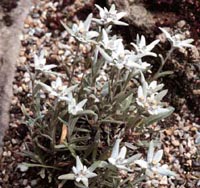Resource Library
Plant of the Week: Edelweiss
The University of Arkansas System Division of Agriculture does not promote, support or recommend plants featured in "Plant of the Week." Please consult your local Extension office for plants suitable for your region.
Plant of the Week
Edelweiss
Latin: Leontopodium alpinum

Like millions of other American TV viewers, I recently sat down and watched the 35th
anniversary showing of The Sound of Music -- one of the most beloved musicals of all time. One of the songs, "Edelweiss" is
about a wildflower. Being as most of us know only what we see on TV, it might be interesting
to look at this little plant and place it in perspective.
Edelweiss is a small wooly perennial in the daisy family that grows about 6 inches
tall when in full bloom. It grows throughout Europe in the Alps but also extends into
the Pyrenees and Caucasus regions. It grows in full sun in alpine meadows having well
drained calcareous soils.
In summer, a stem shoots from the basal rosette of wooly leaves bearing a 2-inch
wide star-shaped cluster of white-wooly bracts clustered around a central display
of inconspicuous florets. The Latin name of the species translates as "lion’s foot"
for the wooly, star-like character of the inflorescence.
Linc Foster, the now deceased godfather of American rock gardening says of edelweiss,
"this is the species that adorns the traveler’s hat" in Europe. It is the national
flower of Switzerland. Apparently, it is easy to dry and has been collected extensively
for that purpose, so is now a protected species.
The song "Edelweiss" is not an adaptation of a native folk song of Austria or any
European country. It was the last song that Rogers and Hammerstein wrote together
in 1959 for the stage performance of their play, The Sound of Music.
Hammerstein, who knew he was dying when he collaborated on the song, died about nine
months after completing the work. Of course the 1965 film version of the performance
where actor Christopher Plummer sang Edelweiss while portraying Captain von Trapp
burned this small plant into our collective consciousness, but in reality most Europeans
would have trouble picking it out in a lineup.
This classic film, directed by Robert Wise and stared in by Julie Andrews, has become
a worldwide classic. A friend from Malaysia tells me that on Children’s Day - the
Asian equivalent of Mother’s or Father’s day in the US -- the movie is broadcast every
year and the family sits down to enjoy it together.
The movie won five Academy Awards, including the award for Best Picture when it was
released. But unlike many award winners, The Sound of Music has those special qualities that make it a timeless classic.
Edelweiss seed is available and can be grown in the rock garden, but it’s run will
probably be much shorter than the four years the movie ran in U.S. movie houses when
released. It germinates easily, but must be watered carefully to keep it from drowning
out as a seedling.
Once in the garden, edelweiss should be sited in a nook between rocks that has a
well drained rock garden soil consisting of five parts coarse grit, one part crushed
limestone and one part compost. Then, provided the humidity doesn’t turn the plant
to mush in August, it should struggle along for a year or two despite our summer heat.
By: Gerald Klingaman, retired
Extension Horticulturist - Ornamentals
Extension News - December 22, 2000
The University of Arkansas System Division of Agriculture does not maintain lists of retail outlets where these plants can be purchased. Please check your local nursery or other retail outlets to ask about the availability of these plants for your growing area.